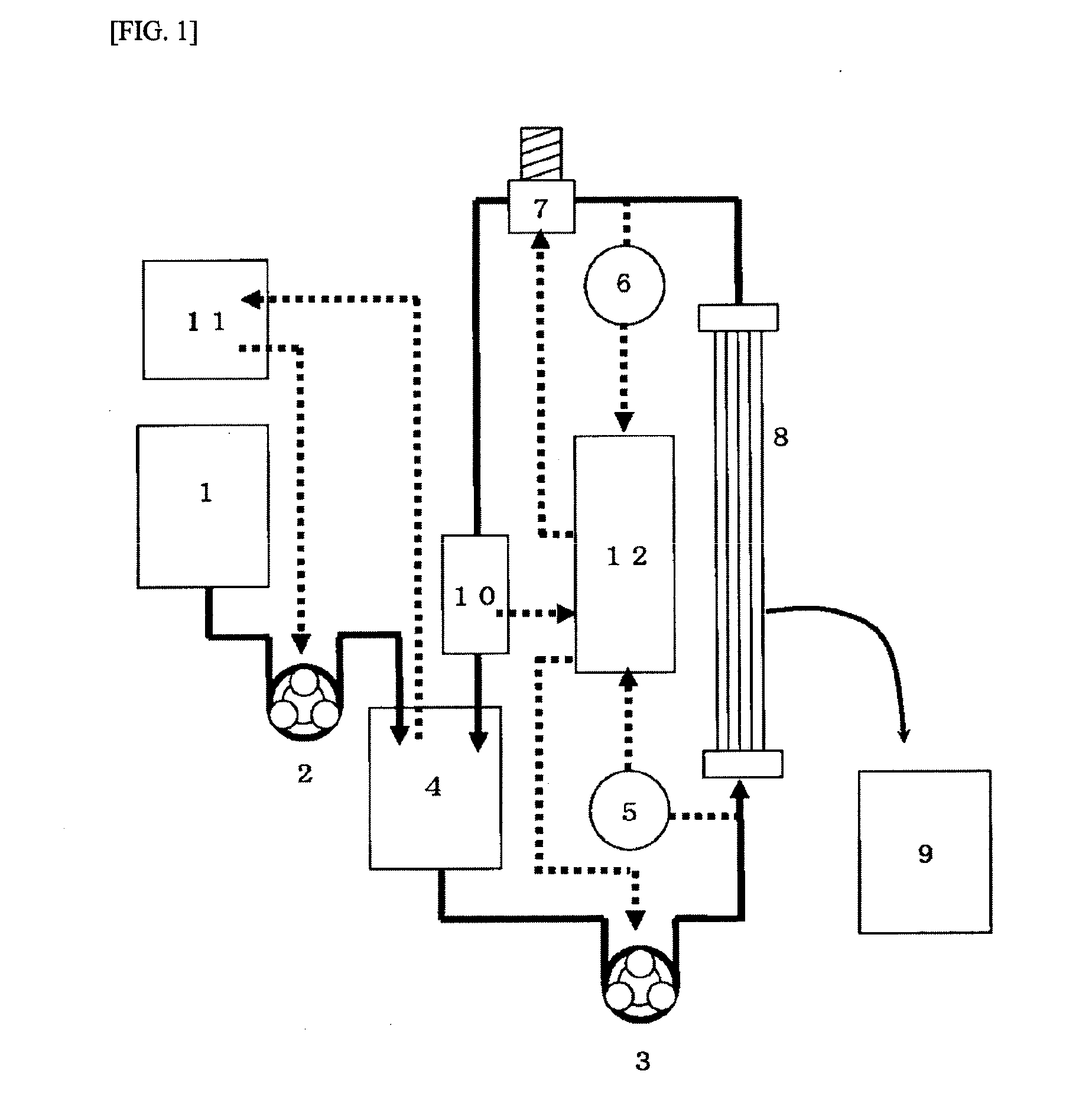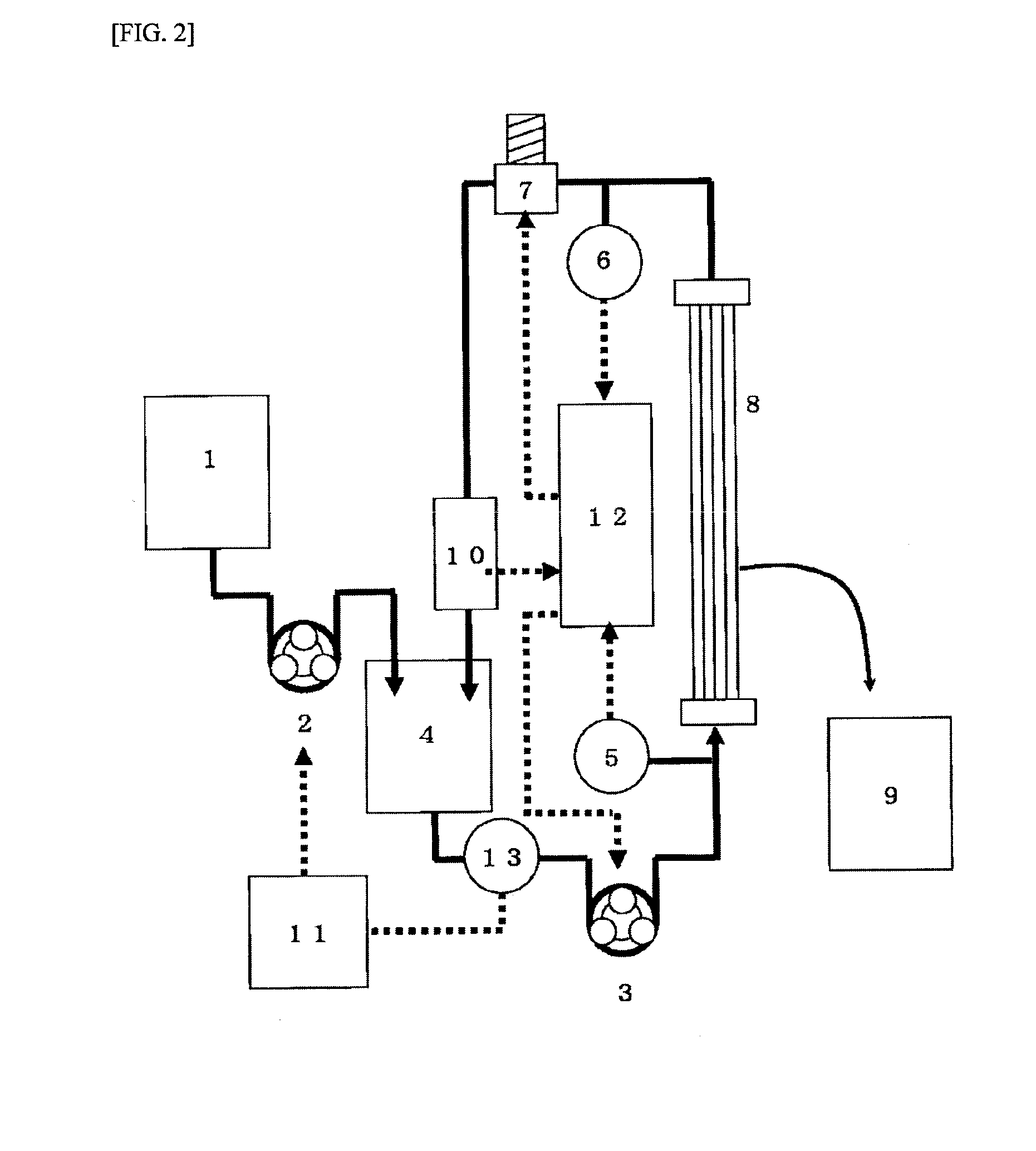Method for separation of immunoglobulin monomers
a technology of immunoglobulin and monomers, which is applied in the field of accurately separating immunoglobulin monomers, can solve the problems of difficult decomposition of the immunoglobulin aggregate that has been formed, affecting the efficiency of immunoglobulin dimers, and affecting the ability of immunoglobulin monomers to be efficiently removed, and the effect of removing immunoglobulin dimers
- Summary
- Abstract
- Description
- Claims
- Application Information
AI Technical Summary
Benefits of technology
Problems solved by technology
Method used
Image
Examples
example 1
[0573]The hollow fiber membranes (PSf-1) were bundled so that the total hollow cross-sectional area was 0.005 m2 to obtain a fiber bundle for evaluating the human immunoglobulin monomer / dimer fractionation performance. The fiber bundle was connected to the cross-flow filtration apparatus shown in FIG. 3.
[0574]A human immunoglobulin solution (0.01 g / L) containing lysine hydrochloride (50 g / L) was placed in the apparatus. The supply pump 2 (3) was rotated while adjusting the control valve 1 (7) so that the linear velocity inside the hollow fiber membrane was 10 cm / sec and the average outlet pressure was 0.010 MPa. A PBS aqueous solution containing lysine hydrochloride (50 g / L) contained in the diluent tank (1) was added to the immunoglobulin stock solution tank (4) so that the concentration of the human immunoglobulin was constant during filtration. A cake layer was formed on the surface of the membrane by filtering the immunoglobulin solution for 20 minutes. A human immunoglobulin so...
example 2
[0578]The hollow fiber membranes (PSf-1) were bundled so that the total hollow cross-sectional area was 0.01 m2 to obtain a fiber bundle for evaluating the human immunoglobulin monomer / dimer fractionation performance. The fiber bundle was connected to the cross-flow filtration apparatus shown in FIG. 3.
[0579]A human immunoglobulin solution (10 g / L) containing lysine hydrochloride (50 g / L) was placed in the apparatus. The supply pump 2 (3) was rotated while adjusting the control valve 1 (7) so that the linear velocity inside the hollow fiber membrane was 10 cm / sec and the outlet pressure was 0.010 MPa. A PBS aqueous solution containing lysine hydrochloride (50 g / L) contained in the diluent tank (1) was added to the immunoglobulin stock solution tank (4) so that the concentration of the human immunoglobulin was constant during filtration. The immunoglobulin solution was subjected to cross-flow filtration at 25° C. for five hours. The permeation amount of the human immunoglobulin monom...
example 3
[0581]Polysulfone-based hollow fiber membranes having a molecular weight cut-off of 45,000, 190,000, 210,000, 240,000, 360,000, and 420,000 were produced by appropriately changing the amount of purified water and the amount of DMAc in the internal coagulation liquid. The hollow fiber membranes were bundled so that the total hollow cross-sectional area was 0.005 m2 to obtain a fiber bundle for evaluating the human immunoglobulin monomer / dimer fractionation performance. The fiber bundle was connected to the cross-flow filtration apparatus shown in FIG. 3. A human immunoglobulin solution (10 g / L) containing lysine hydrochloride (50 g / L) was placed in the apparatus. The supply pump 2 (3) was rotated while adjusting the control valve 1 (7) so that the linear velocity inside the hollow fiber membrane was 10 cm / sec and the outlet pressure was 0.010 MPa. A PBS aqueous solution containing lysine hydrochloride (50 g / L) contained in the diluent tank (1) was added to the immunoglobulin stock so...
PUM
| Property | Measurement | Unit |
|---|---|---|
| concentration | aaaaa | aaaaa |
| concentration | aaaaa | aaaaa |
| molecular weight | aaaaa | aaaaa |
Abstract
Description
Claims
Application Information
 Login to View More
Login to View More - R&D
- Intellectual Property
- Life Sciences
- Materials
- Tech Scout
- Unparalleled Data Quality
- Higher Quality Content
- 60% Fewer Hallucinations
Browse by: Latest US Patents, China's latest patents, Technical Efficacy Thesaurus, Application Domain, Technology Topic, Popular Technical Reports.
© 2025 PatSnap. All rights reserved.Legal|Privacy policy|Modern Slavery Act Transparency Statement|Sitemap|About US| Contact US: help@patsnap.com



